Content
Published:
This is an archived release.
Prisoners mostly Norwegian, but not those in custody
Seventy per cent of all prisoners in 2012 had Norwegian citizenship, but among those in custody, the majority were from other countries.
| All types of imprisonment | Custody | Prison sentence, institution | Prison sentence, electronic monitoring | Preventive detention | Serving sentence for non-payment of a fine | |
|---|---|---|---|---|---|---|
| 1Prison sentence by electronic monitoring not included. | ||||||
| Prison population per 1 January | 4 052 | 910 | 2 910 | 80 | 84 | 68 |
| New imprisonments | 11 620 | 3 837 | 5 637 | 1 312 | 1 | 833 |
| Discharges | 11 543 | 2 184 | 6 963 | 1 385 | 9 | 1 002 |
| Days of imprisonment | 1 348 230 | 346 765 | 943 461 | .. | 30 436 | 27 568 |
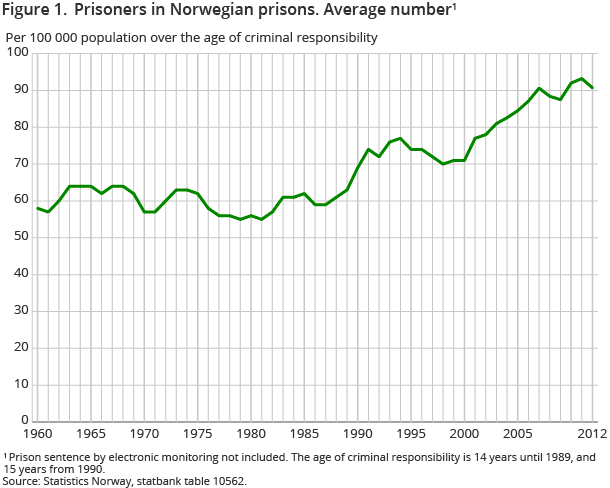
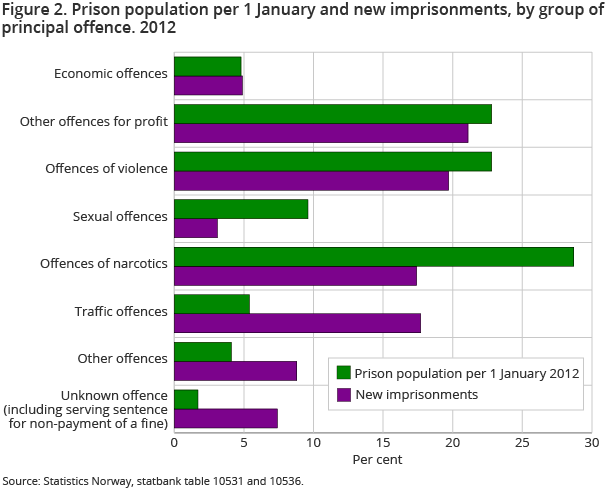
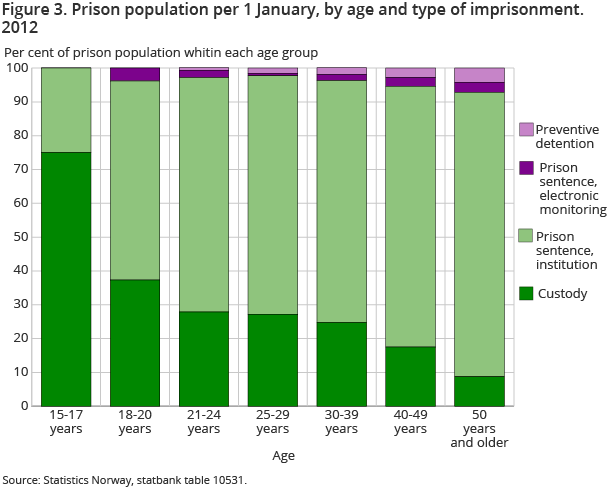
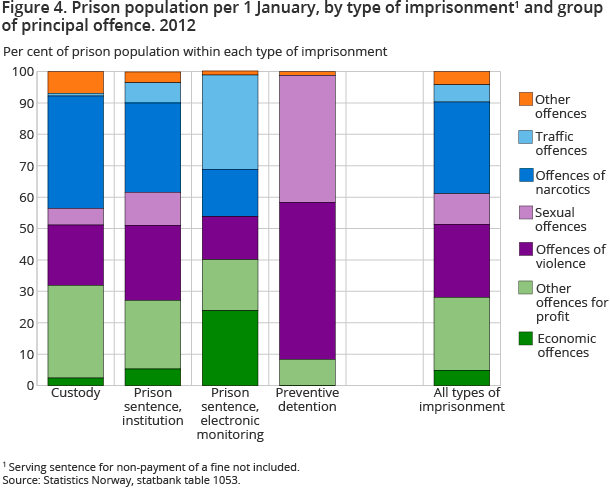
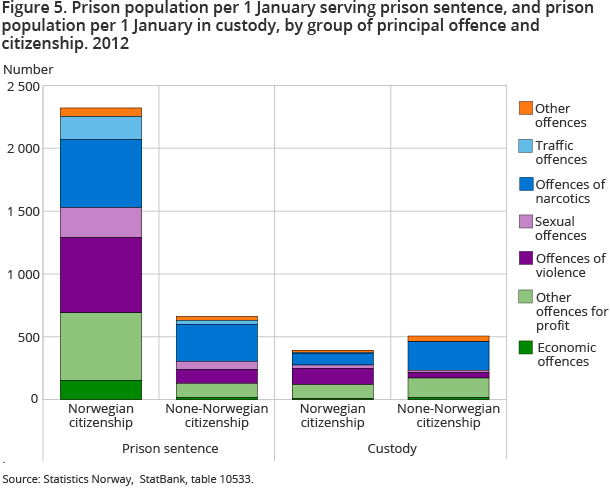
Of the 4 052 prisoners at the beginning of the year in 2012, almost 74 per cent were serving a prison sentence and more than 22 per cent were being held in custody. In addition, those under preventive detention and those serving a sentence for non-payment of a fine made up about 2 per cent. In total, there were almost 5 per cent more persons serving a prison sentence on 1 January 2012 than a year earlier.
Many types of offences lead to imprisonments
Of the total prison population at the beginning of the year, 29 per cent had drug offences, 23 per cent had offences for profit and 23 per cent offences of violence as their principal offence. Offences by prisoners who are in prison at any given time vary considerably from those we see among prisoners entering prison in a single year (see figure 2).
For instance, of a total of 11 620 new imprisonments in 2012, the principal offence was a traffic offence for 18 per cent of cases, while the share among prisoners at the beginning of the year was 5 per cent. Drug offences were the principal offence for a much lower share of new imprisonments, with 17 per cent in 2012, than among those who are in prison at any given time. There is a corresponding trend for sexual offences, which was the principal offence for 3 per cent of new imprisonments in 2012 and 10 per cent of the prisoners at the beginning of the year.
Many in custody for drug offences
The type of imprisonment that is applied varies with the age of the prisoner (see figure 3) and the type of offence for which they are imprisoned, among other things. For instance, drug offences were the principal offence for 36 per cent of the 910 who were in custody at the beginning of the year in 2012. Larceny and other offences for profit were the principal offence for 29 per cent of persons in custody, and the corresponding figure for violence was 19 per cent (see figure 4).
Stable majority of men and most aged 30 years and older
Among those in prison at the beginning of 2012, 94 per cent were men, which is roughly the same share as in the preceding ten years. Of the prisoners with a known age, 65 per cent were aged 30 or older. This share is higher than the years 2001-2005, but was relatively stable for the seven years following that period.
Of all prisoners aged 30 or younger at the beginning of the year, 58 per cent had either offences for profit or violent crimes as a principal offence. The corresponding share among those aged 30 or older was much lower, at 40 per cent. Compared to those aged 30 or younger, those aged 30 or older had a much larger share of drug offences, economic offences and traffic offences as a principal offence. Of a total of 255 women in prison at the beginning of the year, 35 per cent had drugs as a principal offence, while the corresponding share for men was 29 per cent.
More spending long periods in custody, and more serving long prison sentences
Of a total of 3 878 discharges from custody and transfers made directly from custody to serving prison sentences, 1 594 were held for 60 days or longer. This is 7 per cent more than in 2011, and as much as 55 per cent more than in 2008.
Also among those who had a discharge from prison, more prisoners had served a relatively long prison sentence. Of a total of 8 348 discharges from prison in 2012, 2 137 prisoners had served at least three months, which is over 7 per cent more than in 2011. The number of shorter prison sentences in 2012 was about the same as the previous year.
70 per cent of prisoners are Norwegian citizens
Of all prisoners on 1 January with a known citizenship , 70 per cent were Norwegian. In addition, 17 per cent were from another European country, and those with a citizenship from countries in Africa made up 7.5 per cent.
Of a total of 1 182 foreign citizens who were in prison at the beginning of the year, 57 per cent were from another European country. Of these 678 persons, almost half were from either Lithuania (141), Poland (111) or Romania (67).
Norwegian citizens serve a prison sentence, foreign citizens serve in custody
When we group the different types of imprisonments and principal offence groups, we see that there are large disparities between those with Norwegian and those with a foreign citizenship. Of all Norwegian citizens who were in prison at the beginning of the year, more than 83 per cent served a prison sentence and only 14 per cent were in custody. Of all prisoners with a foreign citizenship, less than 57 per cent served a prison sentence and almost 44 per cent were in custody (see figure 5).
Custody most used for foreign citizens, in particular for drug offences
Foreign citizens made up more than half; 57 per cent, of all persons in custody, and 22 per cent of all who served a prison sentence. Over half, or 53 per cent, of all new imprisonments in custody during the year involved persons with a foreign citizenship.
The types of offences that normally result in custody vary in part from the offences that result in other types of imprisonment (see figure 4). The fact that foreign citizens serve relatively more sentences in custody than Norwegian citizens is reflected in the disparity in principal offences between these two groups. For instance, foreign citizens made up 45 per cent of all prisoners on 1 January with drug offence as their principal offence. The corresponding share among those who were in custody was as high as 71 per cent.
More serving their sentence using electronic monitoring
On 1 January 2012, 80 prisoners were serving a prison sentence using electronic monitoring (EM) . During the year, there was a total of 1 327 new cases of EM, and a total of 1 397 cases where the EM ended. This is a 44 per cent increase in those serving a sentence using electronic monitoring from 2011. Of all completed prison sentences during 2012, almost 17 per cent were released from a sentence using EM.
Half of those released from serving a sentence using EM in 2012 had a traffic offence as their principal offence, of which 80 per cent were driving under the influence of alcohol. However, most of those who are sentenced to prison have a traffic offence as their principal offence. Out of the total of 1 985 persons who were sentenced to prison with a traffic offence as their principal offence and released in 2012, 65 per cent were released from a prison institution.
Expanded statistics on imprisonments now available in StatBankOpen and readClose
The statistics have been expanded, and certain terms changed (see more in About the statistics). Among other things, figures that break down prisoners by citizenship are included for the first time. The statistics for 2012 also have far more figures and more detailed figures on type of imprisonment, type of offence, age, sex and prison time. These changes were enabled by a change by Statistics Norway in the processing procedures of the raw data and a quality improvement of the raw data from the Norwegian Central Criminal Record and Police Information System (SSP).
Better raw data material causes break in time seriesOpen and readClose
The extraction of data from SSP for the 2012 statistics was done in February 2014; about a year later than previous practice. Parts of the statistics for 2012 are, therefore, a complete count of the actual occurrences compared to previous years. The disparities between previous years and 2012 are not of any great significance to the figures on prisoners per 1 January or the discharges. For the figures on new imprisonments and transfers made directly from custody to serving a prison sentence, and particularly with regard to the most severe crimes with a long processing time in the criminal justice system, there is a substantial break in the time series from the statistical year 2012. Further reading is available in About the statistics, including in the chapter on Sources of error.
Contact
-
Susanne Fjelldalen
E-mail: susanne.fjelldalen@ssb.no
tel.: (+47) 40 90 26 43
-
Kristin Bergvall
E-mail: kristin.bergvall@ssb.no
tel.: (+47) 92 66 55 13
-
Reid Jone Stene
E-mail: reid.jone.stene@ssb.no
tel.: (+47) 99 02 22 01
